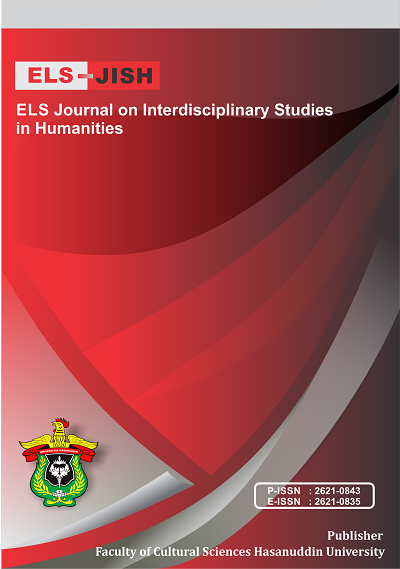Teacher's Feedback in Intensive Speaking Program
DOI:
https://doi.org/10.34050/els-jish.v3i2.10370Keywords:
interaction, feedbackAbstract
Interaction plays a very important role in the classroom between students and teachers. This research was conducted to study the ways teachers initiate the interaction and give feedback to the students’ responses and was also meant to find out the students’ and teachers’ views towards their interaction in the classroom.Case study was conducted in an English institution mediating the teachers and students with different goals in the context of one student and one teacher in a class. This study employed observation to see the ways teachers initiate the interaction and give feedback to the students’ responses. Interview was undertaken to know students’ and teachers’ views towards their interaction in the classroom. There were 5 cases observed. This research was conducted following the series of data collection, data reduction, and data display. Interview was conducted to help gain the views from students and teachers.The result shows that the teachers initiated the interaction and gave feedback by employing all strategies with different frequency. However, student was also found to give initiation which gave much contribution to the continuation of the interaction during the teaching and learning process. It is really recommended for the next researchers to study on the non-linguistic strategies employed by teachers to initiate and give feedback since they were also found during the observation of this study.Downloads
References
Aldabbus, Shaban. (2008). An Investigation into the Impact of Language Games on Classroom Interaction and Pupil Learning in Libyan EFL Primary Classrooms. (Unpublished Thesis submitted for the degree of Doctor of Philosophy Integrated PhD in Education). Newcastle University School of Education, Communication, and Language Sciences. Newcastle.
Ary, Donald, Lucy Cheser Jacobs, and Chris Sorensen. (2010). Introduction to Research in Education. Wadsworth: Cengage Learning.
Bhattacherjee, Anol. (2012). Social Science Research: Principles, Methods, and Practices, 2nd Ed. Zurich: Creative Commons Attribution 3.0 License, Jacobs Foundation.
Bogdan, Robert C. and Sari Knopp Biklen. (2007). Qualitative Research for Education An Introduction to Theory and Methods, 5th Ed. Boston: Pearson Education Inc.
Choudhury, Shaheena. (2005). Interaction in Second Language Classrooms. BRAC University Journal, 2 (1), pp. 77-82.
Fawbush, Ben. (2010). Implicit and Explicit Corrective Feedback for Middle School ESL Learners. Minnesota: Retrieved from https://www.lap- publishing.com
Ibrahim, Mahmoud Elsayed Hamed. (2012). Classroom Interaction in Second Language Teaching and Learning in the Vocational Education Development Centre (VEDC). (Unpublished Dissertation submitted in partial fulfillment of Master of Education). TESOL Faculty of Education.
Jones, Sarah. (2009). Application of the Sinclair and Coulthard Discourse Model to a Korean University English Conversation Course. Retrieved from www.birmingham.ac.uk/Documents/college.../JonesSD .pdf .
Kasim, Usman. (2004). Classroom Interaction in the English Department Speaking Class at State University of Malang. Jurnal Ilmu Pendidikan, Oktober 2004, 11 (3).
Liu, Jingxia and Le Thao. (2012). A Case Study on College English Classroom Discourse. International Journal of Innovative Interdisciplinary Research Issue 2 ISSN 1839-9053.
Love, Robert. (2012). Using IRF Pattern to Analyze Classroom Interaction. Retrieved from www.academia.edu/5145333/Using_the_IRF_pattern_to_analyse_classroom_interaction_undergraduate_assignment_2012_ robert love irf
Miles, Matthew B., A. Michael Huberman, and Johnny Saldana. (2014). Qualitative Data Analysis: A Methods Sourcebook. California: SAGE Publications, Inc.
Nassaji, H. and Wells, G. (2000). What’s the Use of “Triadic Dialogue”?: An Investigation of Teacher-Student Interaction. Applied Linguistics, 21 (3). Pp. 376-406.
Nugent, Tisome T. (2009). The Impact of Teacher-Student Interaction on Student Motivation and Achievement. A dissertation submitted in partial fulfillment of the requirements for the degree of Doctor of Education in the Department of Educational Research, Technology and Leadership in the College of Education at the University of Central Florida Orlando, Florida.
Rashidi, Nasser and Rafieerad, Mahshid. (2010). Analyzing Patterns of Classroom Interaction in EFL Classrooms in Iran. The Journal of Asia TEFL, 7 (3), pp. 93-120, Autumn 2010.
Sinclair, John McHardy & Coulthard, Malcolm. 1975. Towards an Analysis of Discourse. London: Oxford University Press.
Stojkovic, Marija. (2012). Using the Sinclair and Coulthard Model of Discourse Analysis for Examining Classroom Communication in University Level ELT. Univerzitet u Nišu Filozofski Fakultet.
Suryati, Nunung. (2015). Classroom Interaction Strategies Employed by English Teachers at Lower Secondary Schools. TEFLIN Journal, 26 (2), July 2015 http://dx.doi.org/10.15639/teflinjournal.v26i2/247-264.
Walsh, Steve. (2011). Exploring Classroom Discourse: Language in Use. New York: Routledge.
Yousefi, Azam and Koosha, Mansour. (2013). A Descriptive Study of Teacher/Learner Interactions at the MA Level of the Fields of Teaching English as a Foreign Language, General Linguistics, and Translation Studies. International Research Journal of Applied and Basic Sciences (IRJABS), 4 (11), 3312-3323, 2013 www.irjabs.com.

















